'The Invisible Collection' is a short story included in the collection 'Kaleidoscope', published by Stefan Zweig in 1934. It should be of special interest to anybody who loves woodblock prints ...
THE INVISIBLE COLLECTION An Episode of the Inflation Period in Germany Stefan Zweig AT THE FIRST JUNCTION beyond Dresden, an elderly gentleman entered our compartment, smiled genially to the company, and gave me a special nod, as if to an old acquaintance. Seeing that I was at a loss, he mentioned his name. Of course I knew him! He was one of the most famous connoisseurs and art-dealers in Berlin. Before the war, I had often purchased autographs and rare books at his place. He took the vacant seat opposite me, and for a while we talked of matters not worth relating. Then, changing the conversation, he explained the object of the journey from which he was returning. It had, he said, been one of the strangest of his experiences in the thirty-seven years he had devoted to the occupation of artpedlar. Enough introduction. I will let him tell the story in his own words - without using quote-marks - to avoid the complication of wheels within wheels. You know [he said] what has been going on in my trade since the value of money began to diffuse into the void like gas. War profiteers have developed a taste for old masters (Madonnas and so on), for incunabula, for ancient tapestries. It is difficult to satisfy their craving; and a man like myself, who prefers to keep the best for his own use and enjoyment, is hard put to it not to have his house stripped bare. If I let them, they would buy the cuff-links from my shirt and the lamp from my writing-table. Harder and harder to find wares to sell. I’m afraid the term ‘wares” may grate upon you in this connexion, but you must excuse me. I have picked it up from customers of the new sort. Evil communications . . . Through use and wont I have come to look upon an invaluable book from one of the early Venetian presses much as the philistine looks upon an overcoat that cost so or so many hundred dollars, and upon a sketch by Guercino as animated by nothing more worthy of reverence than the transmigrated soul of a banknote for a few thousand francs. Impossible to resist the greed of these fellows with money to burn. As I looked round my place the other night, it seemed to me that there was so little left of any real value that I might as well put up the shutters. Here was a fine business which had come down to me from my father and my grandfather; but the shop was stocked with rubbish which, before 1914, a street-trader would have been ashamed to hawk upon a hand-cart. In this dilemma, it occurred to me to flutter the pages of our old ledgers. Perhaps I should be put on the track of former customers who might be willing to resell what they had bought in prosperous days. True, such a list of sometime purchasers has considerable resemblance to a battlefield laden with the corpses of the slain; and in fact I soon realized that most of those who had purchased from the firm when the sun was shining were dead or would be in such low water that it was probable they must have sold anything of value among their possessions. However, I came across a bundle of letters from a man who was presumably the oldest yet alive - if he was alive. But he was so old that I had forgotten him, since he had bought nothing after the great explosion in the summer of 1914. Yes, very, very old. The earliest letters were dated more than half a century back, when my grandfather was head of the business. Yet I could not recall having had any personal relationships with him during the thirty-seven years in which I had been an active worker in the establishment. All indications showed that he must have been one of those antediluvian eccentrics, a few of whom survive in German provincial towns. His writing was copperplate, and every item in his orders was underlined in red ink. Each price was given in words as well as figures, so that there could be no mistake. These peculiarities, and his use of torn-out fly-leaves as writing paper, enclosed in a scratch assortment of envelopes, hinted at the penuriousness of a confirmed backwoodsman. His signature was always followed by his style and title in full: “Forest Ranger and Economic Councillor, Retired; Lieutenant, Retired; Holder of the Iron Cross First Class.” Since he was obviously a veteran of the war of 1870—1871, he must by now be close on eighty. For all his cheese-paring and for all his eccentricities, he had manifested exceptional shrewdness, knowledge, and taste as collector of prints and engravings. A careful study of his orders, which had at first totalled very small sums indeed, disclosed that in the days when a taler could still pay for a pile of lovely German woodcuts, this country bumpkin had got together a collection of etchings and the like outrivalling the widely trumpeted acquisitions of war profiteers. Merely those which, in the course of decades, he had bought from us for trifling sums would be worth a large amount of money today; and I had no reason to suppose that he had failed to pick up similar bargains elsewhere. Was his collection dispersed? I was too familiar with what had been going on in the art trade since the date of his last purchase not to feel confident that such a collection could scarcely have changed hands entire without my getting wind of the event. If he was dead, his treasures had probably remained intact in the hands of his heirs. The affair seemed so interesting that I set forth next day (yesterday evening) on a journey to one of the most out-of-the-way towns in Saxony. When I left the tiny railway station and strolled along the main street, it seemed to me impossible that anyone inhabiting one of these gimcrack houses, furnished in a way with which you are doubtless familiar, could possibly own a full set of magnificent Rembrandt etchings together with an unprecedented number of Durer woodcuts and a complete collection of Mantegnas. However, I went to the post-office to inquire, and was astonished to learn that a sometime Forest Ranger and Economic Councillor of the name I mentioned was still living. They told me how to find his house, and I will admit that my heart beat faster than usual as I made my way thither. It was well before noon. The connoisseur of whom I was in search lived on the second floor of one of those jerry-built houses which were run up in such numbers by speculators during the sixties of the last century. The first floor was occupied by a master tailor. On the second landing to the left was the nameplate of the manager of the local post-office, while the porcelain shield on the right-hand door bore the name of my quarry. I had run him to earth! My ring was promptly answered by a very old, white-haired woman wearing a black lace cap. I handed her my card and asked whether the master was at home. With an air of suspicion she glanced at me, at the card, and then back at my face once more. In this God-forsaken little town a visit from an inhabitant of the metropolis was a disturbing event. However, in as friendly a tone as she could muster, she asked me to be good enough to wait a minute or two in the hall, and vanished through a doorway. I heard whispering, and then a loud, hearty, masculine voice: “Herr Rackner from Berlin, you say, the famous dealer in antiquities? Of course I shall be delighted to see him.” Thereupon the old woman reappeared and invited me to enter. I took off my overcoat, and followed her. In the middle of the cheaply furnished room was a man standing up to receive me. Old but hale, he had a bushy moustache and was wearing a semi-military frogged smoking-jacket. In the most cordial way, he held out both hands towards me. But though this gesture was spontaneous and nowise forced, it was in strange contrast with the stiffness of his attitude. He did not advance to meet me, so that I was compelled (I must confess I was a trifle piqued) to walk right up to him before I could shake. Then I noticed that his hand, too, did not seek mine, but was waiting for mine to clasp it. At length I guessed what was amiss. He was blind. Ever since I was a child I have been uncomfortable in the presence of the blind. It embarrasses me, produces in me a sense of bewilderment and shame to encounter anyone who is thoroughly alive, and yet has not the full use of his senses. I feel as if I were taking an unfair advantage, and I was keenly conscious of this sensation as I glanced into the fixed and sightless orbs beneath the bristling white eyebrows. The blind man, however, did not leave me time to dwell upon this discomfort. He exclaimed, laughing with boisterous delight: “A red-letter day, indeed! Seems almost a miracle that one of the big men of Berlin should drop in as you have done. There’s need for us provincials to be careful, you know, when a noted dealer such as yourself is on the war-path. We’ve a saying in this part of the world: ‘Shut your doors and button up your pockets if there are gipsies about!’ I can guess why you’ve taken the trouble to call. Business doesn’t thrive, I’ve gathered. No buyers or very few, so people are looking up their old customers. I’m afraid you’ll draw a blank. We pensioners are glad enough to find there’s still some dry bread for dinner. I’ve been a collector in my time, but now I’m out of the game. My buying days are over." I hastened to tell him he was under a misapprehension, that I had not called with any thought of effecting sales. Happening to be in the neighbourhood I felt loath to miss the chance of paying my respects to a longstanding customer who was at the same time one of the most famous among German collectors. Hardly had the phrase passed my lips when a remarkable change took place in the old man’s expression. He stood stiffly in the middle of the room, but his face lighted up and his whole aspect was suffused with pride. He turned in the direction where he fancied his wife to be, and nodded as if to say, “D’you hear that?” Then, turning back to me, he resumed - having dropped the brusque, drill-sergeant tone he had previously used, and speaking in a gentle, nay, almost tender voice: “How charming of you. . . . I should be sorry, however, if your visit were to result in nothing more than your making the personal acquaintanceship of an old buffer like myself. At any rate I’ve something worth while for you to see - more worth while than you could find in Berlin, in the Albertina at Vienna, or even in the Louvre (God’s curse on Paris!). A man who has been a diligent collector for fifty years, with taste to guide him, gets hold of treasures that are not to be picked up at every streetcorner. Lisbeth, give me the key of the cupboard, please.” Now a strange thing happened. His wife, who had been listening with a pleasant smile, was startled. She raised her hands towards me, clasped them imploringly, and shook her head. What these gestures signified was a puzzle to me. Next she went up to her husband and touched his shoulder saying: “Franz, dear, you have forgotten to ask our visitor whether he may not have another appointment; and, anyhow, it is almost dinner-time. - I am sorry,” she went on, looking to me, “that we have not enough in the house for an unexpected guest. No doubt you will dine at the inn. If you will take a cup of coffee with us afterwards, my daughter Anna Maria will be here, and she is much better acquainted than I am with the contents of the portfolios.” Once more she glanced piteously at me., It was plain that she wanted me to refuse the proposal to examine the collection there and then. Taking my cue, I said that in fact I had a dinner engagement at the Golden Stag, but should be only too delighted to return at three, when there would be plenty of time to examine anything Herr Kronfeld wanted to show me. I was not leaving before six o’clock. The veteran was as pettish as a child deprived of a favourite toy. “Of course,” he growled, “I know you mandarins from Berlin have extensive claims on your time. Still, I really think you will do well to spare me a few hours. It is not merely two or three prints. I want to show you, but the contents of twenty-seven portfolios, one for each master, and all of them full to bursting. However, if you come at three sharp, I dare say we can get through by six." The wife saw me out. In the entrance hall, before she opened the front door, she whispered: “Do you mind if Anna Maria comes to see you at the hotel before you return? It will be better for various reasons which I cannot explain just now." “Of course, of course, a great pleasure. Really, I am dining alone, and your daughter can come along directly you have finished your own meal.” An hour later, when I had removed from the dining-room to the parlour of the Golden Stag, Anna Maria Kronfeld arrived. An old maid, wizened and diffident, plainly dressed, she contemplated me with embarrassment. I did my best to put her at her ease, and expressed my readiness to go back with her at once, if her father was impatient, though it was short of the appointed hour. At this she reddened, grew even more confused, and then stammered a request for a little talk before we set out. “Please sit down,” I answered. “I am entirely at your service." She found it difficult to begin. Her hands and her lips trembled. At length: “My mother sent me. We have to ask a favour of you. Directly you get back, Father will want to show you his collection; and the collection ... the collection. Well, there’s very little of it left.” She panted, almost sobbed, and went on breathlessly: “I must be frank ... You know what troublous times we are passing through, and I am sure you will understand. Soon after the war broke out, my father became completely blind. His sight had already been failing. Agitation, perhaps, contributed. Though he was over seventy, he wanted to go to the front, remembering the fight in which he had taken part so long ago. Naturally there was no use for his services. Then, when the advance of our armies was checked, he took the matter very much to heart, and the doctor thought that may have precipitated the oncoming of blindness. In other respects, as you will have noticed, he is vigorous. Down to 1914 he could take long walks, and go out shooting. Since the failure of his eyes, his only pleasure is in his collection. He looks at it every day. ‘Looks at it,’ I say, though he sees nothing. Each afternoon he has the portfolios on the table, and fingers the prints one by one, in the order which many years have rendered so familiar. Nothing else interests him. He makes me read reports of auctions; and the higher the prices, the more enthusiastic does he become. “There’s the dreadful feature of the situation. Father knows nothing about the inflation; that we are ruined; that his monthly pension would not provide us with a day’s food. Then we have others to support. My sister’s husband was killed at Verdun, and there are four children. These money troubles have been kept from him. We cut down expenses as much as we can, but it is impossible to make ends meet. We began to sell things, trinkets and so on, without interfering with his beloved collection. There was very little to sell, since Father had always spent whatever he could scrape together upon woodcuts, copperplate engravings, and the like. The collector’s mania! Well, at length it was a question whether we were to touch the collection or to let him starve. We didn’t ask permission. What would have been the use? He hasn’t the ghost of a notion how hard food is to come by, at any price; has never heard that Germany was defeated and surrendered Alsace-Lorraine. We don’t read him items of that sort from the newspapers! “The first piece we sold was a very valuable one, a Rembrandt etching, and the dealer paid us a long price, a good many thousand marks. We thought it would last us for years. But you know how money was melting away in 1922 and 1923. After we had provided for our immediate needs, we put the rest in a bank. In two months it was gone! We had to sell another engraving, and then another. That was during the worst days of inflation, and each time the dealer delayed settlement until the price was not worth a tenth or a hundredth of what he had promised to pay. We tried auction-rooms, and were cheated there too, though the bids were raised by millions. The million- or milliard-mark notes were waste-paper by the time we got them. The collection was scattered to provide daily bread, and little of that. “That was why Mother was so much alarmed when you turned up today. Directly the portfolios are opened, our pious fraud will be disclosed. He knows each item by touch. You see, every print we disposed of was immediately replaced by a sheet of blank cartridge-paper of the same size and thickness, so that he would notice no difference when he handled it. Feeling them one by one, and counting them, he derives almost as much pleasure as if he could actually see them. He never tries to show them to anyone here, where there is no connoisseur, no one worthy to look at them; but he loves each of them so ardently that I think his heart would break if he knew they had been dispersed. The last time he asked someone to look at them, it was the curator of the copperplate engravings in Dresden, who died years ago. “I beseech you” - her voice broke - ”not to shatter his illusion, not to undermine his faith, that the treasures he will describe to you are there for the seeing. He would not survive the knowledge of their loss. Perhaps we have wronged him; yet what could we do? One must live. Orphaned children are more valuable than old prints. Besides, it has been life and happiness to him to spend three hours every afternoon going through his imaginary collection, and talking to each specimen as if it were a friend. Today may be the most enthralling experience since his sight failed. How he has longed for the chance of exhibiting his treasures to an expert! If you will lend yourself to the deception ..." In my cold recital, I cannot convey to you how poignant was this appeal. I have seen many a sordid transaction in my business career; have had to look on supinely while persons ruined by inflation have been diddled out of cherished heirlooms which they were compelled to sacrifice for a crust. But my heart has not been utterly calloused, and this tale touched me to the quick. I need hardly tell you that I promised to play up. We went to her house together. On the way I was grieved (though not surprised) to learn for what preposterously small amounts these ignorant, though kind-hearted women had parted with prints many of which were extremely valuable and some of them unique. This confirmed my resolve to give all the help in my power. As we mounted the stairs we heard a jovial shout: “Come in! Come in!” With the keen hearing of the blind, be had recognized the footsteps for which he had been eagerly waiting. “Franz usually takes a siesta after dinner, but excitement kept him awake today,” said the old woman with a smile as she let us in. A glance at her daughter showed her that all was well. The stack of portfolios was on the table. The blind collector seized me by the arm and thrust me into a chair which was placed ready for me. “Let’s begin at once. There’s a lot to see, and time presses. The first portfolio contains Durers. Nearly a full set, and you’ll think each cut finer than the others. Magnificent specimens. Judge for yourself.” He opened the portfolio as he spoke, saying: “We start with the Apocalypse series, of course.” Then, tenderly, delicately (as one handles fragile and precious objects), he picked up the first of the blank sheets of cartridge-paper and held it admiringly before my sighted eyes and his blind ones. So enthusiastic was his gaze that it was difficult to believe he could not see. Though I knew it to be fancy, I found it difficult to doubt that there was a glow of recognition in the wrinkled visage. “Have you ever come across a finer print? How sharp the impression. Every detail crystal-clear. I compared mine with the one at Dresden; a good one, no doubt, but ‘fuzzy’ in contrast with the specimen you are looking at. Then I have the whole pedigree.” He turned the sheet over and pointed at the back so convincingly that involuntarily I leaned forward to read the nonexistent inscriptions. “The stamp of the Nagler collection, followed by those of Remy and Esdaille. My famous predecessors never thought that their treasure would come to roost in this little room.” I shuddered as the unsuspecting enthusiast extolled the blank sheet of paper; my flesh crept when he placed a fingernail on the exact spot where the alleged imprints had been made by long-dead collectors. It was as ghostly as if the disembodied spirits of the men he named had risen from the tomb. My tongue clave to the roof of my mouth - until once more I caught sight of the distraught countenances of Kronfeld’s wife and daughter. Then I pulled myself together and resumed my role. With forced heartiness, I exclaimed: “Certainly you are right. This specimen is peerless.” He swelled with triumph. “But that’s nothing,” he went on. “Look at these two, the Melancholia, and the illuminated print of the Passion. The latter, beyond question, has no equal. The freshness of the tints! Your colleagues in Berlin and the custodians of the public galleries would turn green with envy at the sight.” I will not bore you with details. Thus it went on, a pean, for more than two hours, as he ransacked portfolio after portfolio. An eerie business to watch the handling of these two or three hundred blanks, to chime in at appropriate moments with praise of merits which for the blind collector were so eminently real that again and again (this was my salvation) his faith kindled my own. Once only did disaster loom. He was “showing” me a first proof of Rembrandt’s
Aneic pe, which must have been of inestimable value and which had doubtless been sold for a song. Again he dilated on the sharpness of the print, but as he passed his fingers lightly over it the sensitive tips missed some familiar indentation. His face clouded, his mouth trembled, and he said: “Surely, surely it’s the
Aneic pe? No one touches the wood-cuts and etchings but myself. How can it have got misplaced?” “Of course it’s the
Aneic pe, Herr Kronfeld,” I said, hastening to take the 'print' from his hand and to expatiate upon various details which my own remembrance enabled me to conjure up upon the blank surface. His bewilderment faded. The more I praised, the more gratified he became, until at last he said exultantly to the two women: “Here’s a man who knows what’s what! You have been inclined to grumble at my ‘squandering’ money upon the collection. It’s true that for half a century and more I denied myself beer, wine, tobacco, travelling, visits to the theatre, books, devoting all I could spare to these purchases you have despised. Well, Herr Rackner confirms my judgment. When I am dead and gone, you’ll be richer than anyone in the town, as wealthy as the wealthiest folk in Dresden, and you’ll have good reason for congratulating yourself on my ‘craze.’ But so long as I’m alive, the collection must be kept together. After I’ve been boxed and buried, this expert or another will help you to sell. You’ll have to, since my pension dies with me.” As he spoke, his fingers caressed the despoiled portfolios. It was horrible and touching. Not for years, not since 1914, had I witnessed an expression of such unmitigated happiness on the face of a German. His wife and daughter watched him with tear-dimmed eyes, yet ecstatically, like those women of old who - affrighted and rapturous - found the stone rolled away and the sepulchre empty in the garden outside the wall of Jerusalem. But the man could not have enough of my appreciation. He went on from portfolio to portfolio, from “print to print,” drinking in my words, until, outwearied, I was glad when the lying blanks were replaced in their cases and room was made to serve coffee on the table. My host, far from being tired, looked rejuvenated. He had story after story to tell concerning the way he had chanced upon his multifarious treasures, wanting, in this connexion, to take out each relevant piece once more. He grew peevish when I insisted, when his wife and daughter insisted, that I should miss my train if he delayed me any longer. In the end he was reconciled to my going, and we said good-bye. His voice mellowed; he took both my hands in his and fondled them with the tactile appreciation of the blind. “Your visit has given me immense pleasure,” he said with a quaver in his voice. “What a joy to have been able at long last to show my collection to one competent to appreciate it. I can do something to prove my gratitude, to make your visit to a blind old man worth while. A codicil to my will shall stipulate that your firm, whose probity everyone knows, will be entrusted with the auctioning of my collection.” He laid a hand lovingly upon the pile of worthless portfolios. “Promise me they shall have a handsome catalogue. I could ask no better monument.” I glanced at the two women, who were exercising the utmost control, fearful lest the sound of their trembling should reach his keen ears. I promised the impossible, and he pressed my hand in response. Wife and daughter accompanied me to the door. They did not venture to speak, but tears were flowing down their cheeks. I myself was in little better case. An art-dealer, I had come in search of bargains. Instead, as events turned out, I had been a sort of angel of good-luck, lying like a trooper in order to assist in a fraud which kept an old man happy. Ashamed of lying, I was glad that I had lied. At any rate I had aroused an ecstasy which seems foreign to this period of sorrow and gloom. As I stepped forth into the street, I heard a window open, and my name called. Though the old fellow could not see me, he knew in which direction I should walk, and his sightless eyes were turned thither. He leaned out so far that his anxious relatives put their arms round him lest he should fall. Waving a handkerchief, he shouted: “A pleasant journey to you, Herr Rackner.” His voice rang like a boy’s. Never shall I forget that cheerful face, which contrasted so grimly with the careworn aspect of the passers-by in the street. The illusion I had helped to sustain made life good for him. Was it not Goethe who said: "Collectors are happy creatures"?


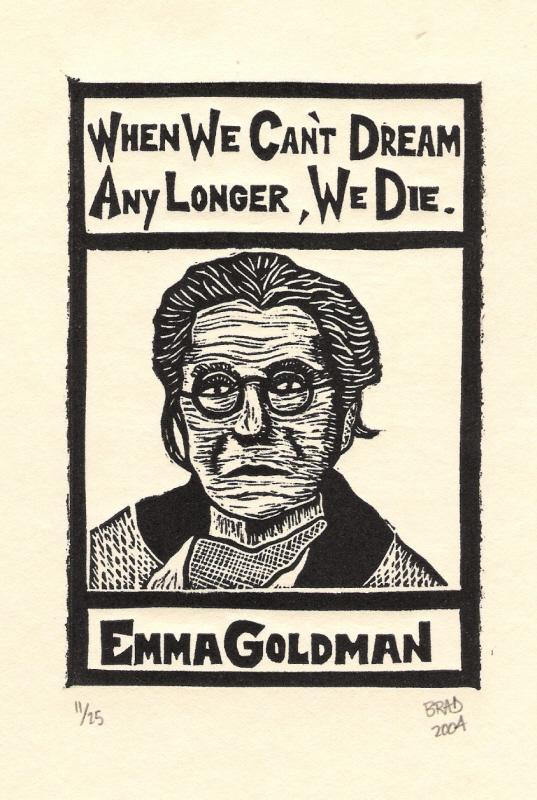


 30cm x 20cm : Birchwood plyblock : printed Moku Hanga technique. Six variant, reduction prints on Gampi vellum paper with Akua inks.
30cm x 20cm : Birchwood plyblock : printed Moku Hanga technique. Six variant, reduction prints on Gampi vellum paper with Akua inks. 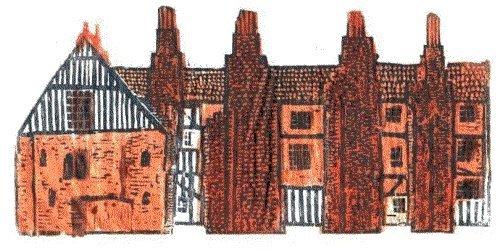 26cmx14cm : Birchwood plyblock : printed Moku Hanga technique.
26cmx14cm : Birchwood plyblock : printed Moku Hanga technique. 


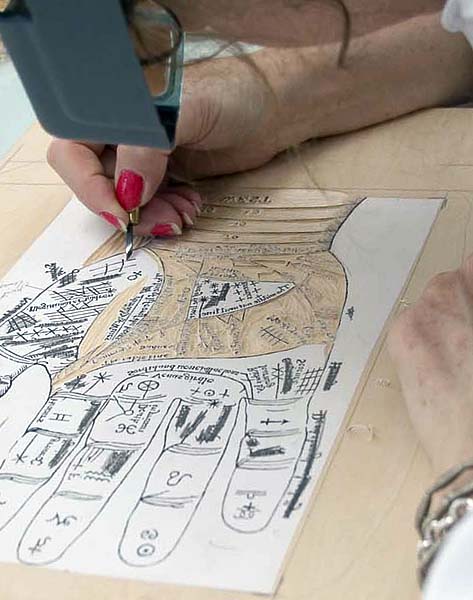
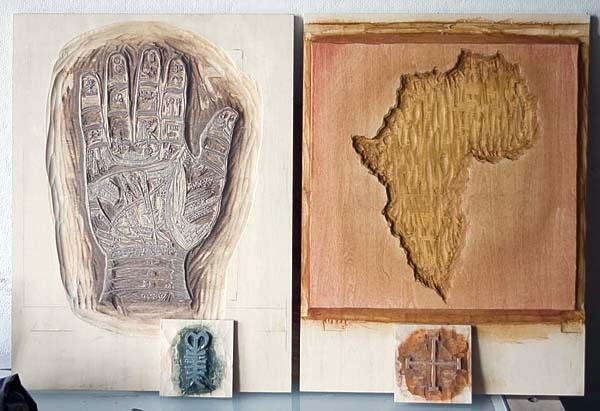
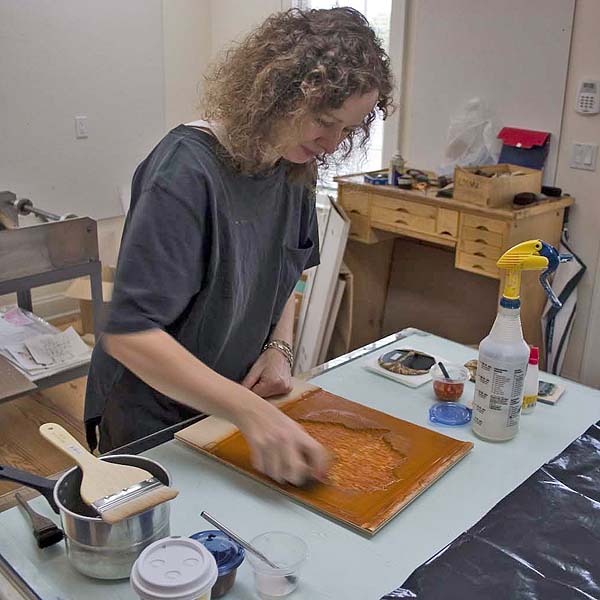
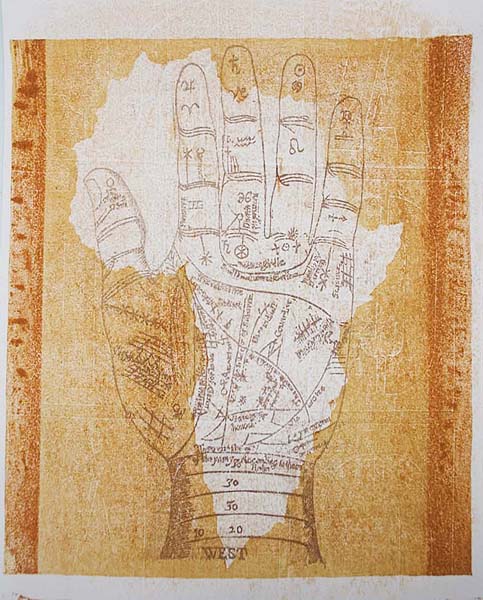







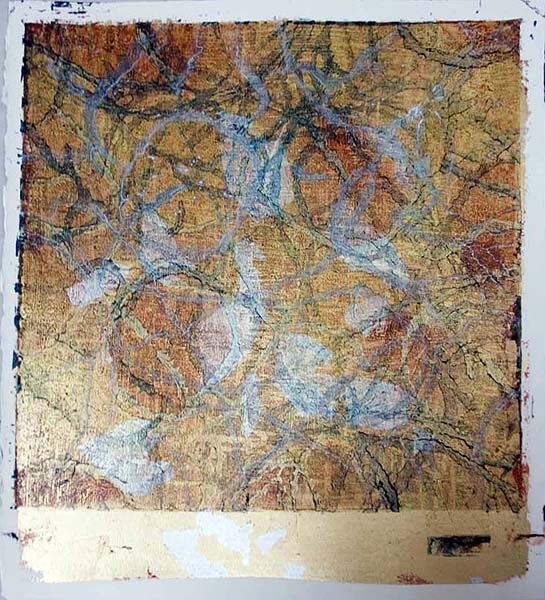



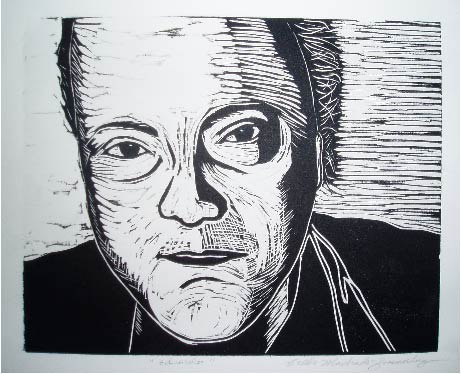
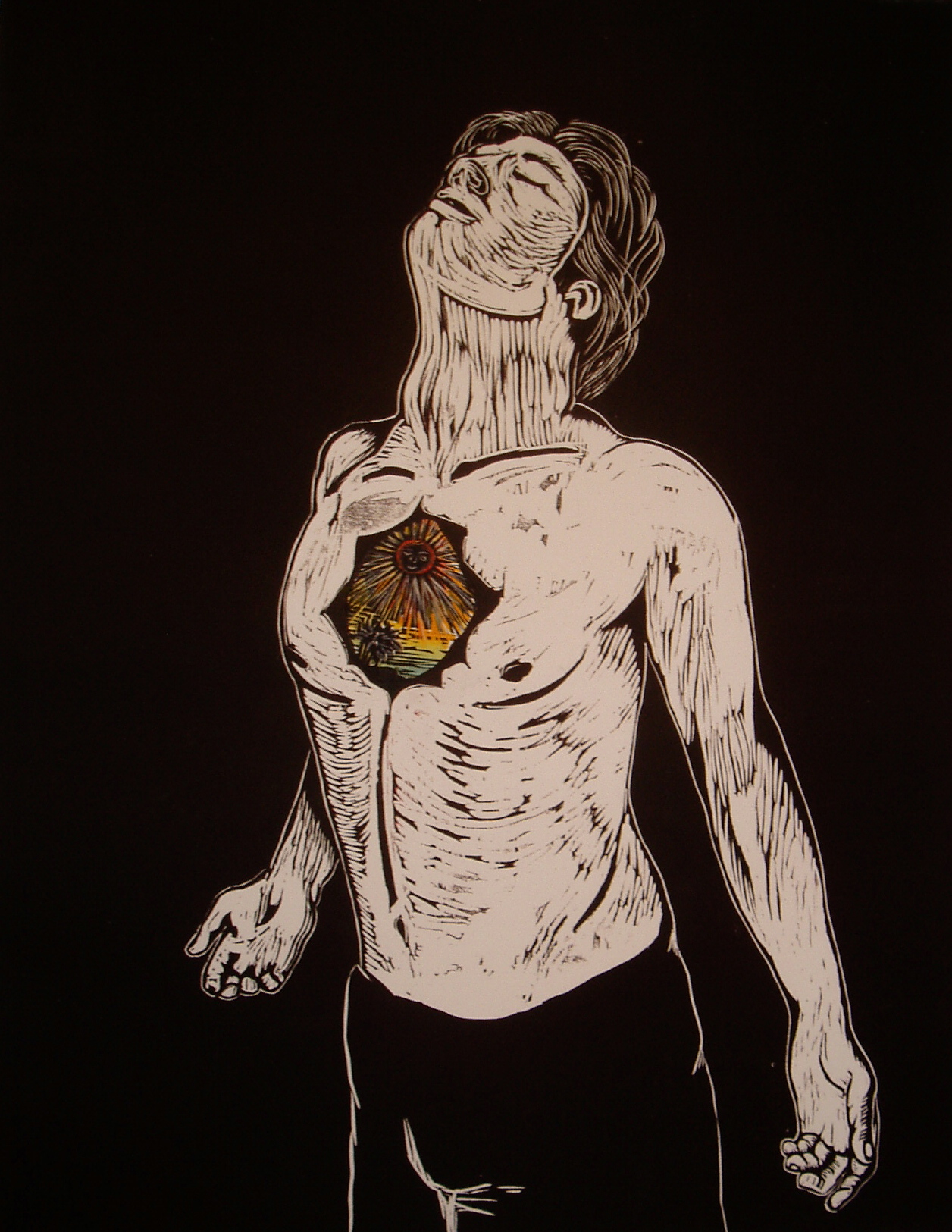 Chest were ripped open, when time stood still, in the hearts of our father's, the past does not die.
Chest were ripped open, when time stood still, in the hearts of our father's, the past does not die. 






 San Francisco de Asis
San Francisco de Asis  Serengeti Plain
Serengeti Plain  Summer Gingko
Summer Gingko  Nuestra Senora de los Dolores
Nuestra Senora de los Dolores




